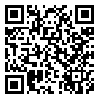1. Payne VG. Human motor development: a lifespan approach. Routledge; 2017. [
DOI]
2. Logan SW, Kipling Webster E, Getchell N, Pfeiffer KA, Robinson LE. Relationship between fundamental motor skill competence and physical activity during childhood and adolescence: a systematic review. Kinesiology Review. 2015;4(4):416–26. [
DOI]
3. Hung W, Pang M. Effects of group-based versus individual-based exercise training on motor performance in children with developmental coordination disorder: a randomized controlled study. J Rehabil Med. 2010;42(2):122–8. [
DOI]
4. Corredor GA, Justicia-Arráez A, Romero-López M, Benavides-Nieto A. longitudinal study of the effects of social competence on behavioral problems. Procedia Soc Behav Sci. 2017;237:479–85. [
DOI]
5. Kordi F, Arsham S, Parvinpour S, Lotfi G. The effect of constraint manipulation (nonlinear method) on the level of intrinsic motivation and skills in girls aged 7 to 9 years. Razi Journal of Medical Sciences 2021;28(9):157–71. [Persian] [
Article]
6. Salehi H, Kalantari P. Effects of task constraints on throwing patterns of children. Motor Behavior. 2019;11(36):105–26. [Persian] [
Article]
7. Jarrett K, Eloi S, Harvey S. Teaching games for understanding (TGfU) as a positive and versatile approach to teaching adapted games. European Journal of Adapted Physical Activity. 2014;7(1):6–20.
8. Tan CWK, Chow JY, Davids K. 'How does TGfU work?': examining the relationship between learning design in TGfU and a nonlinear pedagogy. Phys Educ Sport Pedagogy. 2012;17(4):331–48. [
DOI]
9. Ghorbani Marzoni M, Bahram A, Ghadiri F, Yaali R. The comparison of effectiveness linear and nonlinear pedagogy on manipulation motor skills performance of children. Motor Behavior. 2022;13(45):91–112. [Persian] [
Article]
10. Sahar F. Impact of nonlinear pedagogy to teaching fundamental movement skills (FMS). 2017.
11. Brown T, Lalor A. The movement assessment battery for children—second edition (MABC-2): a review and critique. Phys Occup Ther Pediatr. 2009;29(1):86–103. [
DOI]
12. Pless M, Carlsson M. Effects of motor skill intervention on developmental coordination disorder: a meta-analysis. Adapt Phys Activ Q. 2000;17(4):381–401. [
DOI]
13. Wilson BN, Crawford SG, Green D, Roberts G, Aylott A, Kaplan BJ. Psychometric properties of the Revised Developmental Coordination Disorder Questionnaire. Physical & Occupational Therapy in Pediatrics. 2009;29(2):182–202. [
DOI]
14. Henderson SE, Sugden DA, Barnett AL. Movement assessment battery for children-2. APA PsycTests; 2007. [
DOI]
15. Ulrich DA. Introduction to the special section: evaluation of the psychometric properties of the TGMD-3. J Mot Learn Dev. 2017;5(1):1–4. [
DOI]
16. Salehi H, Afsorde Bakhshayesh R, Movahedi AR, Ghasemi V. Psychometric properties of a Persian version of the Developmental Coordination Disorder Questionnaire in boys aged 6–11 year–old. Psychology of Exceptional Individuals. 2016;1(4):135–61. [Persian] [
Article]
17. Alizadeh B, Ghasemi A, Arabameri E, Rezaey M. Validity and reliability of Movement Assessment Battery for Children–2 Second edition in children whith intellectual disability. Middle Eastern Journal of Disability Studies. 2019;9:38. [Persian] [
Article]
18. Salami S, Rahimian Mashhadi M, Shamsipour Dehkordi P. Validity and reliability of the Test of The Development Motor Skills Development of Ulrich in 7–9 years of girls and boy children in Tehran. Motor Behavior. 2019;11(36):127–48. [Persian] [
Article]
19. Balali M, Vaez Mousavi MK, Ghasemi A. The role of affordances in developing children manipulative movement skills: an application of challenge point framework. Research in Sport Management. 2019;9(17):15–26. [Persian] [
DOI]
20. Richard V, Lebeau JC, Becker F, Boiangin N, Tenenbaum G. Developing cognitive and motor creativity in children through an exercise program using nonlinear pedagogy principles. Creativity Research Journal. 2018;30(40):391–401.
21. Renshaw I, Chow JY, Davids K, Hammond J. A constraints-led perspective to understanding skill acquisition and game play: a basis for integration of motor learning theory and physical education praxis? Physical Education & Sport Pedagogy. 2010;15(2):117–37. [
DOI]
22. Alizadeh L, Mohammad Zadeh H. The role of task constraints manipulation on learning of skills and strategies of basketball by nonlinear pedagogy (TGFU). Motor Behavior. 2020;11(38):115–28. [Persian] [
Article]
23. Chow JY, Davids K, Button C, Shuttleworth R, Renshaw I, Araújo D. Nonlinear pedagogy: a constraints-led framework for understanding emergence of game play and movement skills. Nonlinear Dynamics Psychol Life Sci. 2006;10(1):71–103.
24. Guadagnoli M, Morin MP, Dubrowski A. The application of the challenge point framework in medical education: application of the challenge point framework. Medical Education. 2012;46(5):447–53. [
DOI]

 ، شهاب پروین پور*2
، شهاب پروین پور*2 
 ، مرضیه بلالی3
، مرضیه بلالی3 
 ، زهرا انتظاری خراسانی3
، زهرا انتظاری خراسانی3 




